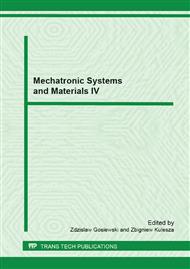p.525
p.533
p.539
p.547
p.553
p.559
p.565
p.571
p.577
Multi-Objective Optimization of the Electromagnetic Actuator Control
Abstract:
This paper presents the linear electromagnetic motor (LEM) which consists of two solenoids and a slide control with neodymium magnet bars placed on its end. The work of the electromagnetic motor is based on the phenomenon of electromagnetic repulsion. The device also includes an electromagnetic brake which allows to stop the slider or to hold the slider in a fixed position, without electricity supply. The range of the slider movement is up to 50mm. The paper deals with the problem of implementation of the Genetic Algorithm GA to calculate Pareto-optimal solutions. In this process, the functions of voltage powering solenoids used to control the position of the linear electromagnetic motor are evaluated. This procedure assumes minimizing two conflicted criteria: the time of movement of the motor and the energy input. In this case the device works in the open-loop system without a feedback loop. The results of the application of the conventional PID controller are also presented, which allows precision positioning up to 1µm. The experimental results are compared with Matlab-Simulink simulations.
Info:
Periodical:
Pages:
553-558
Citation:
Online since:
March 2013
Authors:
Price:
Сopyright:
© 2013 Trans Tech Publications Ltd. All Rights Reserved
Share:
Citation:


